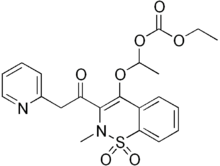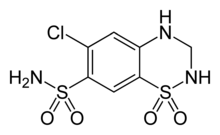Sulfonamide

In chemistry, the sulfonamide functional group (also spelt sulphonamide) is -S(=O)2-NH2, a sulfonyl group connected to an amine group. Relatively speaking this group is unreactive. The amine center is no longer basic. The S-N bond is cleaved only with difficulty. Because of the rigidity of the functional group, sulfonamides are typically crystalline. For this reason, the formation of a sulfonamide is a classic method to convert an amine into a crystalline derivative which can be identified by its melting point. Many important drugs contain the sulfonamide group.[1]
A sulfonamide (compound) is a compound that contains this group. The general formula is RSO2NH2, where R is some organic group. For example, "methanesulfonamide" is CH3SO2NH2. Any sulfonamide can be considered as derived from a sulfonic acid by replacing a hydroxyl group with an amine group.
In medicine, the term "sulfonamide" is sometimes used as a synonym for sulfa drug, a derivative or variation of sulfanilamide.
Synthesis
Sulfonamides can be prepared in the laboratory in many ways. The classic approach entails the reaction of sulfonyl chlorides with an amines.
- RSO2Cl + R2NH → RSO2NR2 + HCl
A base such as pyridine is typically added to absorb the HCl that is generated. Illustrative is the synthesis of sulfonylmethylamide.[2] A readily available sulfonyl chloride source is tosyl chloride.[3] The reaction of primary and secondary amines with benzenesulfonyl chloride is the basis of the Hinsberg reaction, a method for detecting primary and secondary amines.
Triflimide or triflimidic acid HN(Tf)2 (bis(trifluoromethane)sulfonimide) is the formal adduct of triflic acid and ammonia. Phenyl triflimide is a triflating reagent. The related metal triflimidates are used as catalysts. The anion bistriflimide is hydrophobic.
Sultams
Sultams are cyclic sulfonamides. Bioactive sultams include the antiinflammatory ampiroxicam and the anticonvulsant sultiame. Sultams are prepared analogously to other sulfonamides, allowing for the fact that sulfonic acids are deprotonated by amines. They are often prepared by one-pot oxidation of disulfides or thiols linked to amines.[4]
- Sulfonamide-based compounds
-

Sulfanilamide, a compound that foreshadowed the development of sulfa drugs.
-

Sulfamethoxazole is a widely used antibiotic sulfa drug.
-

Ampiroxicam is a sultam used as an antiinflammatory drug.
-

Hydrochlorothiazide is a drug that features both acyclic and cyclic sulfonamide groups.
-

Camphorsultam is a sultam used as a chiral auxiliary in organic synthesis.
Sulfinamides
The related sulfinamides (R(S=O)NHR) are amides of sulfinic acids (R(S=O)OH) (see sulfinyl). Chiral sulfinamides such as tert-butanesulfinamide, p-toluenesulfinamide [5] [6] and 2,4,6-trimethylbenzenesulfinamide [7] are relevant to asymmetric synthesis.
See also
References
- ↑ Actor, P.; Chow, A. W.; Dutko, F. J.; McKinlay, M. A. (2005), "Chemotherapeutics", Ullmann's Encyclopedia of Industrial Chemistry, Weinheim: Wiley-VCH, doi:10.1002/14356007.a06_173
- ↑ Organic Syntheses, Coll. Vol. 4, p.943 (1963); Vol. 34, p.96 (1954). Online Article
- ↑ Organic Syntheses, Coll. Vol. 5, p.39 (1973); Vol. 48, p.8 (1968). Online Article
- ↑ Rassadin, V.; Grosheva, D.; Tomashevskii, A. Sokolov, V. "Methods of Sultam Synthesis" Chemistry of Heterocyclic Compounds 2013, Vol. 49, p39-65. 27. doi:10.1007/s10593-013-1231-3.
- ↑ Organic Syntheses, Coll. Vol. 10, p.47 (2004); Vol. 77, p.50 (2000). Link
- ↑ Org. Synth 2007, 84, 129-138 Link
- ↑ Org. Synth. 2006, 83, 131-140 Link